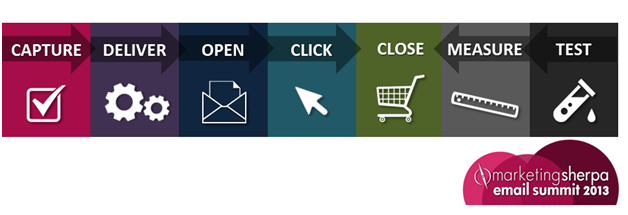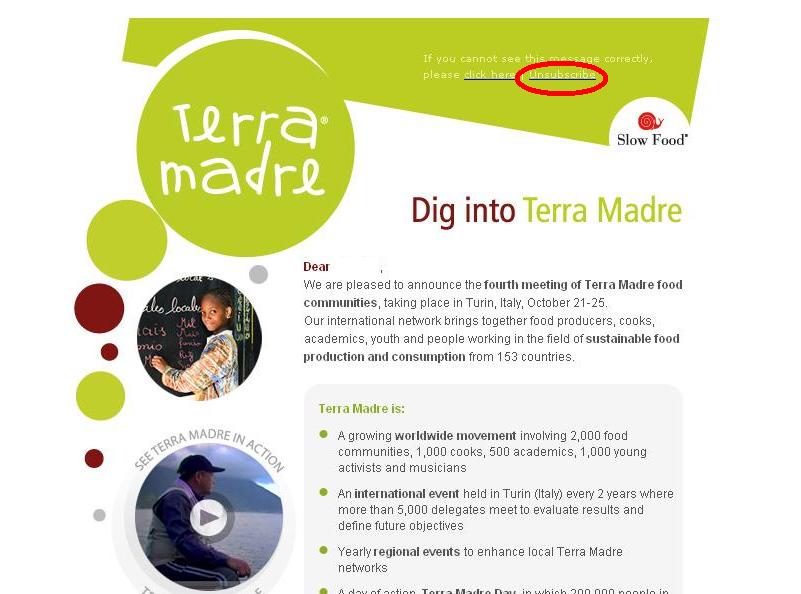Originally published on B2B LeadBlog
Earlier this year at MarketingSherpa Email Summit 2013 in Las Vegas, I had the chance to enjoy many conversations with my email marketing industry friends. This post grew out of one of those talks.
I asked Matt Bailey, President, SiteLogic; Christopher Donald, CEO and Lead Strategist, Inbox Group; and Loren McDonald, VP Industry Relations, Silverpop, about comparing “batch and blast” email strategies against some of the more targeted and personalized email approaches. Here are their answers.
David Kirkpatrick: Email marketers are being told to employ aggressive database hygiene on email subscription lists, engage in tactics such as microsegmentation to individualize and customize the content in email campaigns, and begin emphasizing mobile form factors in email design to encourage engagement with campaigns on mobile devices.
At the same time, they are being told to get away from the traditional batch and blast or “spray and pray” efforts.
What are some advantages and disadvantages of these areas of emphasis in email marketing?
Loren McDonald: Email marketing is not “either-or.” A successful program relies on a combination of elements – broadcast, automated triggered emails and segmentation. Each element has a specific role to play in your email program. If you focus on a single one to the exclusion of the others, you’re leaving money on the table.
First, a well-designed broadcast email program makes sense because you will always have email messages that you should send to everyone on your list.
Part of email’s role is to nudge your customers into buying something they didn’t necessarily know they wanted, to reach out to the person who wasn’t planning to buy from you.
Having said that, I do believe that the more behavior you can capture, the more relevant your messages become, and you can automate more messages. Recipients value these messages because they’re more relevant than most broadcast emails.
Automated messaging helps you capture incremental dollars on top of the revenue you’re driving already with your broadcast emails.
Matt Bailey: As much as neither of us would recommend a batch and blast approach, it is still a “better than nothing” proposition.
I find that in many companies, the traditional email batch marketing is the sole or the primary way of corresponding with existing customers. So, in this way, it is better than no communication. There is little to no time spent improving the database or much thought into the messaging of the emails – it’s simply a task to be done.
Now, fortunately or unfortunately, when I audit these types of companies and their marketing, and come to their email programs – it’s a profitable venture. Because so little is put in, besides the creative, the email service provider (ESP) and the blast, but yet it produces the primary source of repeat business.
I say unfortunately, because many times it is profitable because there is little spent and even less attention to segmentation or database management. I say fortunately, because making simple changes and becoming better and more intelligent with microsegmentation, triggers, etc., will only make an already profitable activity soar in results.
The issue then becomes one of paying more for something that is already working and investing in it to grow. Meanwhile, the sexiness of social media is competing for the marketing budget, and the new sexy options tend to get the attention, whereas the already profitable and predictable email marketing gets overlooked.
Christopher Donald: There is definitely a lot of benefit to being able to segment and target based on the data. We like to look at pretty much everything – from browse data to email data. You know, what [your customers] are responding to and not responding to from previous purchases.
So, you can get segmentation or even microsegmentation. The problem is not everybody has the bandwidth or budget to do that.
So they still live in the batch and blast world, and it can be very effective. There are a lot of companies that all they do is batch and blast, and it does really well for them.
You can increase your ROI and your revenue through targeting and through better segmentation and messaging to those segments based on previous activity, but it takes time and money.
Some people do batch and blast just out of necessity, but that doesn’t mean it doesn’t work.
DK: What effect on that final conversion to sale (rather than other email metrics such as open rate and clickthrough) do these two different approaches exert on campaigns?
LM: The one-to-one approach, especially those emails that are triggered to the individual based on a behavior or event, typically have significantly higher conversion rates than one-size-fits-all broadcast emails.
On the other hand, conversion rates on broadcast emails are typically less than 5%, but the emails are sent to all or a majority of your database versus a tiny percentage on any given day of the one-to-one emails. But with automated email programs, the power and math is in that they are triggered 24/7/365 and that as you build your program you might have dozens of these emails going out every day.
So as I mentioned earlier, the key is to combine a growing number of these one-to-one automated emails with segmented and broadcast. Companies that add a significant number of automated email programs often see them contribute 25% to 50% of their total revenue from email.
MB: Oh, there is no contest. Every test, every campaign and every client that develops microsegmented campaigns or persona-based emails sees lifts in every category. It all comes down to relevance. Even if I have subscribed to your company’s emails, unless it is relevant to my needs – at that exact moment – it is spam. The more targeted your emails [are] by relevance, personalization and timeliness, the more significant all metrics increase, especially the ones that count – revenue and profitability.
CD: I think it all depends on what it is you are selling, right? If you simply sell a widget in 10 different colors, then segmentation probably isn’t important and isn’t even going to get you that much more revenue for the amount of time and cost that will be involved.
Revenue should always be your main indicator.
It is your main indicator of whether what you are doing is working, or not. I have seen clients spend huge amounts of money and time segmenting and on hygiene and managing inactives and doing everything they can do, but the bottom line – the return on investment of doing those things – doesn’t always pan out.
For others, it does. It is really looking at what you are selling. If you are selling lots of different products, it makes all the sense in the world to segment.
DK: Is relying on batch and blast because it still works possibly selling short a longer-term strategy of an engaged, if maybe smaller, subscriber base? And possibly risking eventual issues with deliverability, recipient fatigue (and the resulting opt-outs, or worse, spam/junk status) and/or brand credibility?
LM: If your email program is almost entirely batch and blast, then you are simply leaving a lot of money on the table. That is the fundamental reason to go beyond this approach – deliverability concerns and related issues are secondary. Remember, your goal as a marketer is to make as much money as possible for your employer while at the same time balancing margins, customer expectations, choice, list churn and other factors.
The simple truth is that sending more email makes you more money. But “more” doesn’t mean just sending more of the same old thing to everyone – but more relevant emails at the individual, segment and broadcast level. As my friend Dela Quist of Alchemy Worx says, “Don’t be stupid.”
You have to be responsible with your broadcast program. You must test frequency and monitor engagement across your database. Concentrate on activating your new subscribers right away. Use technology and data to identity customers who are becoming unengaged and then move them into different tracks. You also need to understand the longer-term impact on churn and revenue when simply sending more broadcast emails.
Additionally, one of the goals and purposes of your broadcast program is to drive subscriber behaviors that then trigger those one-to-one emails that lead to higher conversions and engagement. Without the regular cadence of broadcast emails you will have fewer behaviors from which to trigger the highly personalized emails.
MB: Absolutely! I believe that the batch and blast approach is only profitable because we are in a unique place in digital marketing. It’s the “grace period” before we hit a critical mass of personalized, targeted marketing. If your company isn’t doing it, then you will get overwhelmed by your competitors and others who are engaging your customers at a more personal level.
CD: I think it does hurt in the long run, for sure. I think you can turn off your audience over time [with batch and blast email].
But, sometimes it is a knowledge issue. There are a lot of plug-and-play services with recommendations based on browsing, or cart abandonment, or targeting based on data.
Sometimes people are email marketers by default, not by choice.
DK: What emphasis should email marketers place on mobile platforms right now when designing new email campaigns and overall email marketing strategies?
MB: I would look at your metrics to see how your customer base is interacting with your emails. While the data suggests that email is the number one activity on mobile you need to see how that is stacked up for your company. Just because reports state that you still have to see what is happening in your own business.
Now, after verifying how people are using your emails and where they are opening – if you see even the slightest trend or predilection to mobile, then you need to be exploring, designing or planning. Don’t ignore it.
CD: I think [email marketers] should take it very seriously.
You need to find out what percentage of your [audience] are opening and reading on mobile. We have a B2B client with a mobile open rate of only 4%.
You would think [being] business to business, the mobile open rate would be huge, right?
But, with this particular client, they have been sending this newsletter on a monthly basis for seven years and the newsletter is content heavy. It generates 1.6 million PDF downloads of new insurance policy information for agents.
Because it is a large format newsletter and a lot of content, there is no way to make it mobile-friendly.
DK: What are your overall thoughts or ideas you’d like to share on this topic?
LM: While I am a major proponent of one-to-one, behavior-based automated email, success is still all about balance and knowing what works with your customers.
You need to find the right balance among broadcast, one-to-one and segmentation based on your business, resources, budget and customer and purchase lifecycle. If you overemphasize one approach at the expense of the others, you’re leaving money – perhaps a lot of it – on the table.
MB: Metrics are powerful, and they are absolutely necessary to prove our assumptions. Even though your traditional email campaigns are profitable, it doesn’t mean that they will remain so next year. Even the simplest segmentation strategy will make a remarkable difference in your response rates, conversions and even more – the customer perception of your company. All of which will be important as the personalization of digital marketing explodes over the near term.
MarketingSherpa Email Awards 2014
Did this blog post get you thinking about your own email marketing strategies and tactics? If so, let us know about your best campaigns from the past year and enter those efforts in MarketingSherpa Email Awards 2014. You have until September 8, 2013 to enter.
Related Resources:
Email Marketing: 208% higher conversion rate for targeted emails over batch and blast
Automated Email Case Study: 175% more revenue and 83% higher conversion rate
Email Marketing: 900% more revenue-per-email from Restaurant.com’s automated strategy
Email Marketing: Two ways to add relevance, and why you must be correct












